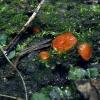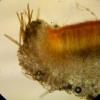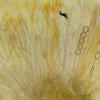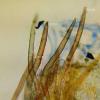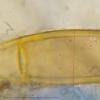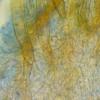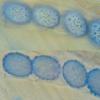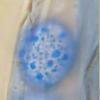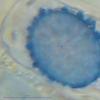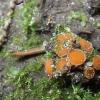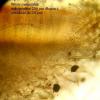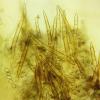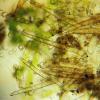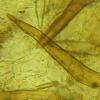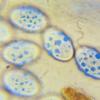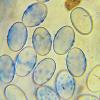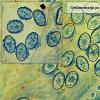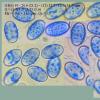
14-11-2025 18:31
 Lothar Krieglsteiner
Lothar Krieglsteiner
Hello,can somebody provide me with a file of:Rothe

14-11-2025 16:26
 Marian Jagers
Marian Jagers
Hello everyone, On dead wood of Cytisus scoparius

12-11-2025 09:25
 Viktorie Halasu
Viktorie Halasu
Hello, I need help with a pale terrestric Pseudom

11-11-2025 20:16
Bohan JiaHi, lastly I have found these tiny yellow decayin

09-11-2025 13:20
Hello.A tiny ascomycete, appearing as erupting gra

08-11-2025 00:29
 Francois Guay
Francois Guay
I found this species in Quebec, Canada, on herbace
Dear forum members, are my suspicions correct about this Scututellinia genre?
The collection consisted of several ascomata, but most were immature. In principle, I studied only one ascomata who was fairly mature. Microscopic features I have observed do not match any genre known to me. The most similar to the features of S. variornata nom. prov.
Spores with dimensions: Me = 19.6 × 15.7 µm; QE = 1.3.
The height of the warts reached almost 2 µm, but I suspect that you need to adopt a slightly greater height due to poorly mature ascomata.
Hair: Most of the length in the range of 200-250 µm.
The length of several marginal hair reached almost 300 µm.
Other features I present in the pictures.
I have a request to you:
Is anyone in possession of a more accurate description of this species? I would like to get acquainted with him.
regards
Mirek
Unfortunately S variornata is one of a few species proposed and as yet only partially described by Benat.
Your find certainly fits with this partial description for the species but until Benat or someone completes this process it can only be put forward as nom. prov.
Mal
Thank you for expressing opinions about this Scututellinia, which confirms my suspicion.
I suspect that probably more species from this kind are still waiting for accurate elaboration and this is just one of them. Maybe Benat will find a bit of time to publish them? We will wait :)
Greetings
Mirek
Again, I found a very similar collection, in a completely different place but in a similar habitat. I wonder what species I am dealing with. The keys lead me, as before, to S. Superba. Unfortunately, some details don't suit me again. Hair up to 250 µm lengths but their width is very small for this species, the widest up to 20µm. Schumacher gives from 15µm to 35 µm. Both in the first and in this collection, the hair rarely exceeds 20µm.
I would ask for your opinion.
Regards
Mirek

You forced me to delve into the subject: D
You had a very good idea with S. heterosculpturata, but some differences are so glaring that I had to look for in literature. In fact, spores fit this species but when I watch the S. parvispora spores drawing, they are also similar to spores in my collection. Do you not think that other features described by J. Moravec better fit my collection?
The size of Apothecia also fits perfectly. Moravec gives 3-5 mm and mine had something about 3.5-4 mm.
However, since Moravec places this species in the S. Umbrorum complex, the ornamentation under the influence of heating should not separate. As you can see in the seventh photo from the top, in my collection the ornamentation detaches after heating?
Some features do not fit perfectly with the original description but basically fit in the norm.
I would like to know your opinion on this subject, of course if you find a free moment to respond to my observations.
Regards
Mirek

Based on Moravec's description and on a collection tentatively named S. parvispora (by me), the latter has wider ascospores than S. heterosculpturata, and also longer hairs.
Nicolas
I used the description of Schumacher to S. heterosculpturata. For this species, Schumacher gives the length of marginal hair to 800 µm.
In turn, Moravec for S. parvispora gives up to 410µm(on average 330x22).
When it comes to spores, the dimensions of the spores are more suited to S. heterosculpturata, but their shape is disputed.
According to the given spores for these species, I calculated Q.
S. heterosculpturata (Schumacher) ... Q = 1.64
S. parvispora (Moravec) ... Q = 1.43
spores of my collection ... Q = 1.50
To be honest, I don't really understand why Schumacher placed S. Parvispora in a group with long and massive hair exceeding 1000µm? However, already in the monograph "The Genus Scitellinia", this species is not there.
Nicolas, do I have old data on hair length for these species? Are there new arrangements?
I have problems with translation sometimes :(
Maybe I misunderstood something?
Regards
Mirek
Schumacher recognized S, Parvispora as synonymous with S. Umbrorum.
In this case, my collection's hair completely does not match the dimensions given to this species; 200-720 (-950) x 24-48
My collection: length up to 200, width up to 20.
Thank you very much but I think I will give up, it will remain Sp.
Mirek

The second one fits S.heterosculpturata, the first one can be discussed.
Of course, I am talking about the second collection and I am aware that these are two other species. First of all, the proportions of the spores are completely different.
I agree with you as much as possible, the spores match S. heterosculpturata, but the nature of the hair does not suit this species, hence my doubts.
I have one more idea, although it may seem stupid. Beñat in his key presents the version of Scutellinia superba spores very similar to mine.
Currently, I do not have access to literature, I am at work, but if I remember well, this species has shorter hair and certainly with a protruding ornamentation after heating?
I also see similar spores on our colleague Enrique's website:
https://www.centrodeestudiosmicologicosasturianos.org/?p=33266
In Enrique, spores are a bit longer so maybe, my collection was not well mature?
Thank you and best regards
Mirek

